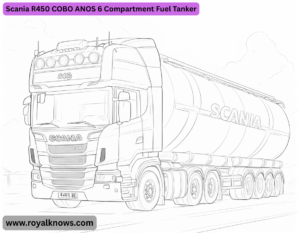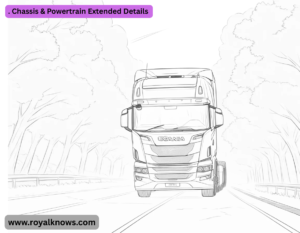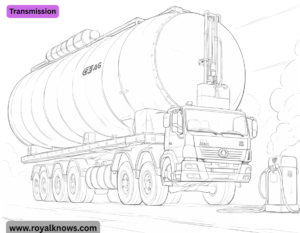Scania R450 COBO ANOS 6 Compartment Fuel Tanker The Scania R450 COBO ANOS 6 Compartment Fuel Tanker is a specialized truck designed for the safe and efficient transportation of fuel. Below are its key features and specifications:
Chassis & Powertrain
- Manufacturer: Scania
- Model: R450
- Engine: DC13 147 (13L, 6-cylinder)
- Power Output: 450 HP
- Torque: 2350 Nm (at 1000-1300 rpm)
- Transmission: Scania Opti cruise (Automated Manual Transmission)
- Axle Configuration: Typically 4×2 or 6×2, depending on regional requirements
- Fuel Tank Capacity (Vehicle): ~600-800L (varies by configuration)
Tanker Specifications
- Tanker Type: Fuel tanker with 6 compartments (ANOS certification)
- Material: Aluminum or stainless steel (corrosion-resistant)
- Capacity: ~36,000–40,000 liters (varies by design & regulations)
- Compartments: 6 individually sealed sections for multi-product transport
- Pump System: Equipped with a high-flow pump (e.g., 500–1000 L/min)
- Metering System: Digital or mechanical gauges for accurate measurement
Safety Features:
- ANOS Certification (European standard for fuel tankers)
- Anti-spill valves
- Grounding system (static electricity prevention)
- Fire suppression system (optional)
- Rear underrun protection
Applications
- Diesel, gasoline, or Ad Blue transport
- Refueling stations, depots, and industrial sites
Additional Features
- COBO (Cab Over Engine) Design: Optimized for maneuverability
- Compliance: ADR (European dangerous goods regulations)
- Telematics: Scania Fleet Management System for tracking & efficiency
1. Chassis & Powertrain Extended Details
- Engine (DC13 147):
- Euro 6 compliant (or regional equivalent, e.g., Euro V/EEV)
- SCR (Selective Catalytic Reduction) + EGR for emissions control
- Fuel efficiency features: Scania’s Eco Roll (coasting function) & predictive cruise control
- Transmission:
- Scania Opti cruise (12-speed automated gearbox) with Retarder or Exhaust Brake
- Optional: Scania GRSO926R (manual 12-speed) for heavy-duty operations
- Axle Options:
- 4×2: Common for lighter loads (~26–36T GCW)
- 6×4: Full traction for off-site refueling (e.g., mining/construction)
2. Tanker Body (ANOS Compliance & Safety)
- ANOS Certification (EN 13012):
- Mandatory in Europe for fuel tankers (ensures leak-proof design, crash resistance, and fire safety).
- Requires:
- Double-skin construction (outer shell protects inner tank)
- Overfill prevention system (90% auto-shutoff)
- Bottom-loading valves (reduces vapor emissions vs. top-loading)
- Compartmentalization:
- Typical 6-compartment layout (e.g., 3x 6,000L + 3x 4,000L for varied fuel types).
- Baffles: Anti-surge plates to stabilize liquid movement.
- Pump & Metering:
- Pump Types:
- Rotary gear pump (500–1,200 L/min flow rate)
- Optional: ATEX-certified for explosive environments
- Meter Accuracy: ±0.5% (legal trade requirement in most countries).
3. Operational Features
- Safety Systems:
- Static Grounding: Cable + interlock system to prevent sparks during loading/unloading.
- Emergency Shutoff: Remote-operated valves (via cab or wireless pendant).
- Ventilation: Pressure/vacuum relief valves for vapor control.
- ADR Compliance (Transporting Dangerous Goods):
- Class 3 (Flammable Liquids) – Requires:
- Orange hazard placards
- Fire extinguishers (2x 6kg powder)
- Driver ADR training certification
- Telematics & Tracking:
- Scania Fleet Management (real-time fuel monitoring, route optimization, theft prevention).
4. Customization Options
- Material Choices:
- Aluminum: Lightweight (~300–400kg lighter than steel), corrosion-resistant.
- Stainless Steel: For aggressive fuels (e.g., biodiesel, ethanol blends).
- Add-ons:
- Heated compartments (for cold climates to prevent fuel gelling).
- Vapor recovery system (environmental compliance).
- Rear-mounted hose reel (for direct refueling of equipment).
- Cab Options:
- Highline Cab: Sleeper berth for long-haul operations.
- Day Cab: For regional/short-haul deliveries.
5. Typical Use Cases
- Petrol Stations: Multi-compartment loads (e.g., diesel + gasoline + kerosene).
- Aviation Fuel: Dedicated stainless steel tanks for Jet-A1 (requires additional certifications).
- Industrial Sites: Off-road fuel delivery to mining/farming operations.
6. Maintenance & Lifespan
- Service Intervals: Every 60,000–90,000 km (Scania’s modular engine design reduces downtime).
- Tanker Lifespan: 15–20 years with proper care (aluminum resists rust better than steel).
7. Pricing & Lead Time
- Estimated Cost:
- Truck (R450 COBO): €120,000–€150,000 (new, depending on specs).
- ANOS Tanker Body: €80,000–€120,000 (6 compartments, aluminum).
- Lead Time: 6–12 months (custom builds require ANOS testing/certification).
Key Questions to Ask When Ordering:
- ADR Class Needed? (e.g., Class 3 for diesel/gasoline, Class 6.1 for additives).
- Local Weight Limits? (e.g., 36T vs. 44T GCW in Europe).
- Loading Type? (Bottom-load vs. top-load, vapor recovery compatibility).
- Climate Adaptations? (Insulated tanks for Arctic conditions).
1. Chassis & Powertrain (Extended Details)
- Engine (DC13 147):
- Euro 6 compliant (or regional equivalent, e.g., Euro V/EEV)
- SCR (Selective Catalytic Reduction) + EGR for emissions control
- Fuel efficiency features: Scania’s Eco Roll (coasting function) & predictive cruise control
- Transmission:
- Scania Opti cruise (12-speed automated gearbox) with Retarder or Exhaust Brake
- Optional: Scania GRSO926R (manual 12-speed) for heavy-duty operations
- Axle Options:
- 4×2: Common for lighter loads (~26–36T GCW)
- 6×4: Full traction for off-site refueling (e.g., mining/construction)
2. Tanker Body (ANOS Compliance & Safety)
- ANOS Certification (EN 13012):
- Mandatory in Europe for fuel tankers (ensures leak-proof design, crash resistance, and fire safety).
- Requires:
- Double-skin construction (outer shell protects inner tank)
- Overfill prevention system (90% auto-shutoff)
- Bottom-loading valves (reduces vapor emissions vs. top-loading)
- Compartmentalization:
- Typical 6-compartment layout (e.g., 3x 6,000L + 3x 4,000L for varied fuel types).
- Baffles: Anti-surge plates to stabilize liquid movement.
- Pump & Metering:
- Pump Types:
- Rotary gear pump (500–1,200 L/min flow rate)
- Optional: ATEX-certified for explosive environments
- Meter Accuracy: ±0.5% (legal trade requirement in most countries).
3. Operational Features
- Safety Systems:
- Static Grounding: Cable + interlock system to prevent sparks during loading/unloading.
- Emergency Shutoff: Remote-operated valves (via cab or wireless pendant).
- Ventilation: Pressure/vacuum relief valves for vapor control.
- ADR Compliance (Transporting Dangerous Goods):
- Class 3 (Flammable Liquids) – Requires:
- Orange hazard placards
- Fire extinguishers (2x 6kg powder)
- Driver ADR training certification
- Telematics & Tracking:
- Scania Fleet Management (real-time fuel monitoring, route optimization, theft prevention).
4. Customization Options
- Material Choices:
- Aluminum: Lightweight (~300–400kg lighter than steel), corrosion-resistant.
- Stainless Steel: For aggressive fuels (e.g., biodiesel, ethanol blends).
- Add-ons:
- Heated compartments (for cold climates to prevent fuel gelling).
- Vapor recovery system (environmental compliance).
- Rear-mounted hose reel (for direct refueling of equipment).
- Cab Options:
- Highline Cab: Sleeper berth for long-haul operations.
- Day Cab: For regional/short-haul deliveries.
5. Typical Use Cases
- Petrol Stations: Multi-compartment loads (e.g., diesel + gasoline + kerosene).
- Aviation Fuel: Dedicated stainless steel tanks for Jet-A1 (requires additional certifications).
- Industrial Sites: Off-road fuel delivery to mining/farming operations.
6. Maintenance & Lifespan
- Service Intervals: Every 60,000–90,000 km (Scania’s modular engine design reduces downtime).
- Tanker Lifespan: 15–20 years with proper care (aluminum resists rust better than steel).
7. Pricing & Lead Time
- Estimated Cost:
- Truck (R450 COBO): €120,000–€150,000 (new, depending on specs).
- ANOS Tanker Body: €80,000–€120,000 (6 compartments, aluminum).
- Lead Time: 6–12 months (custom builds require ANOS testing/certification).
- Key Questions to Ask When Ordering:
ADR Class Needed? (e.g., Class 3 for diesel/gasoline, Class 6.1 for additives). - Local Weight Limits? (e.g., 36T vs. 44T GCW in Europe).
- Loading Type? (Bottom-load vs. top-load, vapor recovery compatibility).
- Climate Adaptations? (Insulated tanks for Arctic conditions).
Advanced Tanker Structural Engineering
- A. Stress Analysis & Finite Element Modeling (FEM)
- Critical Stress Points:
- Bulkhead Welds: Fatigue cracks often initiate here due to cyclic pressure loading.
- Mounting Brackets: High stress at chassis-tanker interface (FEA-recommended reinforcement).
- Simulation Standards:
- EN 13094: Requires FEM for tanks >5,000L capacity under 0.5 bar pressure.
- Load Cases:
- Full Braking (0.8g deceleration) → Tests front bulkhead integrity.
B. Computational Fluid Dynamics (CFD) for Slosh Mitigation
- Simulation Parameters:
- Turbulence Model: k-ε (for high Reynolds number flow).
- Mesh Resolution: 5mm near baffles (critical for vortex prediction).
- Findings:
- Worst-Case Scenario: 50% fill + sudden stop → 12 k N surge force on rear bulkhead.
- Optimal Baffle Design: 30° angled perforations reduce slosh by 40% vs. flat baffles.
Get article on pdf file… Click now



